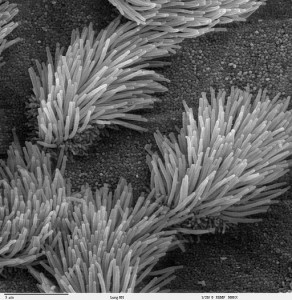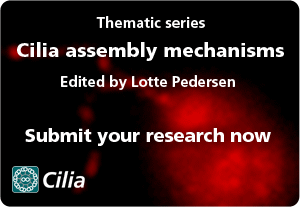
Cilia have a checkered past when it comes to research. Some of these tiny, tail-like structures were once thought to have limited function and were largely ignored by the research community. Over the past two decades, however, new discoveries have radically changed that view.
The motile cilia fared better in this history, as their function was easier to decipher. Projecting from the outside of cells, motile cilia beat in waves and help to move the cell around (or move things around the cell). For example, in the human trachea, motile cilia help to sweep out dirt and mucus from the lungs.
On the other hand, primary cilia are found on almost every cell in the human body (as well as cells in many other eukaryotes), but these little organelles were, until relatively recently, mostly thought to be merely vestigial protuberances.
No more is this the case though. The last two decades have seen a seismic shift in our understanding of all cilia, and particularly the variety of roles that both motile and primary cilia play. Not only are they key in cell motility or sensory perception in specialized cell types like photoreceptors and olfactory neurons, but they are now known to be involved in regulating various signaling pathways and developmental processes throughout most of our body. Consequently, it’s now clear that a growing number of diseases, called ciliopathies, are caused by mutations in genes that affect cilia assembly or function. So much for vestigial!
 The assembly and maintenance of these nearly ubiquitous structures are dependent on a transport system — known as ‘intraflagellar transport’ (IFT) — which moves particles from the cell body out to the tip of the cilium, and then returns them to the cell body. It’s now over 20 years since the discovery of IFT by Joel Rosenbaum’s laboratory and this landmark in our understanding of cilia biology is being marked by the journal Cilia in a new series of articles looking at cilia assembly mechanisms.
The assembly and maintenance of these nearly ubiquitous structures are dependent on a transport system — known as ‘intraflagellar transport’ (IFT) — which moves particles from the cell body out to the tip of the cilium, and then returns them to the cell body. It’s now over 20 years since the discovery of IFT by Joel Rosenbaum’s laboratory and this landmark in our understanding of cilia biology is being marked by the journal Cilia in a new series of articles looking at cilia assembly mechanisms.
The articles published so far in the series serve as further illustration of how much our understanding of cilia has progressed and the range of research that is now being undertaken in this field. One review, by Tsang and Dynlacht summarizes recent advances in our understanding of the control mechanisms that regulate the building of cilia, while another by Bhogaraju et al. provides an up-to-date overview of IFT complex structure and architecture.
Hopefully the progress we’ve made over the last two decades into understanding cilia better will only continue. And as our understanding grows, we can hope that the discovery of new ways to diagnose and treat ciliopathies can but follow. It’s 20 years since the discovery of IFT – where will we be 20 years from now?
![]() Read more about the series on cilia assembly mechanisms on the Cilia website.
Read more about the series on cilia assembly mechanisms on the Cilia website.
Kam Arkinstall
Latest posts by Kam Arkinstall (see all)
- Richard III: ancient DNA solves a 500-year-old mystery - 26th March 2015
- Responding to climate change - 22nd October 2014
- Revealing the secrets of cilia – how 20 years of research have transformed our understanding - 8th January 2014
Comments